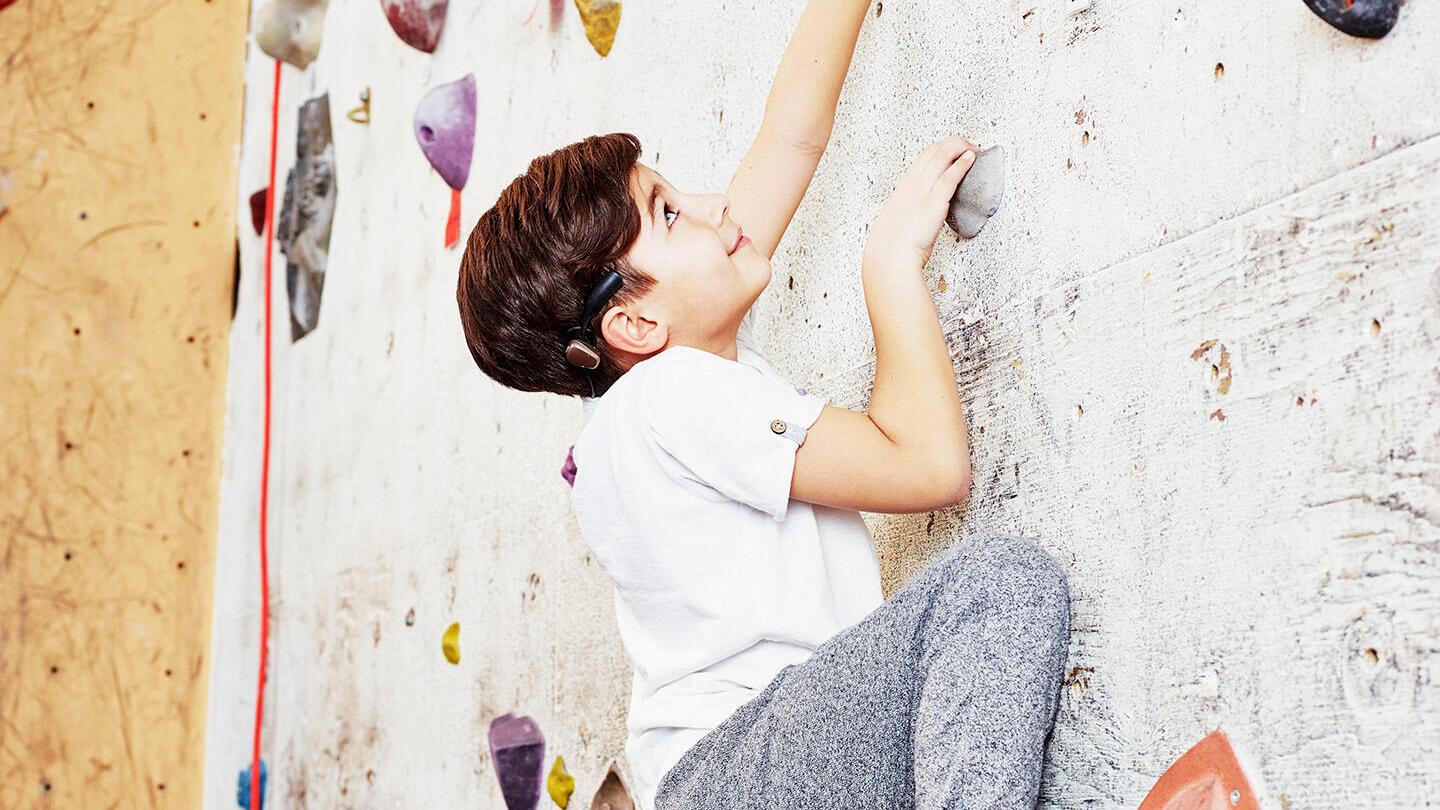MRI and medical considerations
What you need to know about getting an MRI with a Cochlear™ Nucleus®, Baha®, or Osia® implant.
If you or your child needs an MRI (Magnetic Resonance Imaging) scan, you want to know that the procedure is safe. MRI continues to be a common diagnostic tool used in many therapeutic areas.1,2
Recipients of the current and many past generations of Cochlear™ Nucleus® Implants, Cochlear Baha® Implants and Cochlear Osia® Implants can get an MRI. If your doctor has recommended an MRI scan please review the information below as conditions may differ depending on the type of implant you have. For a complete set of instructions on performing an MRI scan safely, refer to the MRI Guidelines for your country.*
MRI for Cochlear™ Nucleus® Systems
Cochlear implants are approved as “MR Conditional” because they contain an internal magnet. This means there are certain instructions that must be followed to ensure a safe MRI scan.1-3 For decades, Cochlear has designed Nucleus Implants with the magnet accessible to help if an MRI is required. In cases where an MRI of the head or neck is needed, the magnet may need to be removed for the MRI to render accurately.
One of our earliest implants, the Nucleus 22 (CI22M) which is no longer being implanted, has two versions. One with a removable magnet and one without. In either case, specific instructions must be followed for the MRI to proceed. 1-3
Cochlear Nucleus Profile Plus, the latest implant offering, provides access to MRI at 1.5T and 3T with magnet in place. The Profile and CI24RE implants do not require magnet removal at 1.5T if an MRI Kit is applied. The magnet needs to be removed at 3T only for these two generations of devices. Older implant generations have varying MRI access based on the specific implant type.
As a cochlear implant recipient, there are specific steps that need to be taken if an MRI is required. The steps are as follows:
- Ensure your radiology center is aware that you have a cochlear implant(s) and certain conditions need to be met for successful scans.
- To obtain a successful MRI, the following items will be required. Please provide the following information to
your radiology center.
- Implant Model Number: The exact model(s) of your Nucleus implant will be required in order to understand
the specific MRI conditions that apply. To find the implant type:
- "Log in to your Cochlear Family account and click "Equipment". You can also find your implant model number using the Nucleus Smart App by clicking "Settings" and then "About".
- If you do not have a Cochlear Family account, you can register here.
- Once you have your implant model number and serial number, consider putting it on your implant identification card. This card was provided at the time of your surgery or may be accessed here.
- If you are unable to register with Cochlear Family, contact Cochlear at 1-866-210-9217.
- MRI Guidelines: The specific implant conditions are outlined within the MRI Guidelines here.
- Implant Model Number: The exact model(s) of your Nucleus implant will be required in order to understand
the specific MRI conditions that apply. To find the implant type:
For professionals seeking further clarity on implant generations and MRI conditions, please click here.
MRI for Cochlear™ Baha® Systems
For the Baha Connect System, as long as the sound processor is removed, you can have MRI scans at 1.5T and 3T.
For the Baha Attract System, an MRI can be performed at 1.5T with the magnet in place. If a 3T strength image is required, the internal magnet should be surgically removed.
Prior to receiving an MRI, please consult with your clinician about proper precautions.
For professionals seeking more information on performing an MRI on a Cochlear Baha Implant recipient, please click here.
MRI for Cochlear™ Osia® System
Osia was designed with the same technology that has allowed for conditional access to MRI for over two decades in Cochlear Nucleus® Implant recipients. This key design feature allows for easy access and removal of the magnet.
he Osia OSI200 implant is MRI conditional for 1.5T with the MRI Kit applied and at 3T with the magnet surgically removed. The Osia OSI300 implant provides access to MRI at 1.5T and 3T with the magnet in place.
For professionals seeking more information on performing an MRI on a Cochlear Osia recipient, please click here.
MRI for Cochlear™ Vistafix® System
As long as the Vistafix prosthesis, bar construction, any fixation magnets, magnabutments or magnacaps are removed for the MRI procedure, a patient fitted with a Vistafix System may be exposed to an MRI examination. When undergoing an MRI, the following conditions apply.
MRI Safety information
The prosthesis, the bar construction, any fixation magnets, magnabutments or magnacaps attached to the implants must be removed before entering a room where an MRI scanner is located.
Non-clinical testing has demonstrated that Vistafix implants, cover screws, and abutments are MR Conditional at 1.5 and 3T. They can be scanned safely under the following conditions. Scanning under other conditions may result in severe patient injury or device malfunction.
- Static magnetic field of 1.5T and 3T only
- Maximum spatial gradient field of 3000 Gauss/cm (30 T/m)
- Maximum MR System reported whole body averaged specific absorption rate (SAR) of 2 W/kg or maximum head averaged SAR of 3.2 W/kg (Normal Operating Mode)
Under the scan conditions defined above, the implant, cover screw, abutment, and healing cap are expected to produce a maximum temperature rise of 1.1 °C after 15 minutes of continuous scanning.
In non-clinical testing with the implant and abutment in place, the image artifact caused by the device extends approximately 1.8 cm from the implant and abutment when imaged with a gradient echo pulse sequence and a 3T MRI system. The artifact is reduced to 1.2 cm from the implant when the abutment is removed.
For professionals seeking more information on performing an MRI on a Cochlear VistaFix recipient please click here.
Disclaimer
Please seek advice from your health professional about treatments for hearing loss. Outcomes may vary, and your health professional will advise you about the factors which could affect your outcome. Always read the instructions for use. Not all products are available in all countries. Please contact your local Cochlear representative for product information.
Views expressed are those of the individual. Consult your health professional to determine if you are a candidate for Cochlear technology.
For a full list of Cochlear’s trademarks, please visit our Terms of Use page.
*Cochlear Osia implants are MR Conditional, meaning they have demonstrated safety in Magnetic Resonance Imaging (MRI) environment within defined conditions. Always read the instructions for use and discuss with your doctor before undertaking any MRI procedure.
References
- D774756 Cochlear Nucleus Implants MRI Guidelines.
- https://www.medel.com/us/cochlear-implants-mri-safety. Cited October 2018.
- https://advancedbionics.com/us/en/home/professionals/hires-ultra-3d-cochlear-implant.html. Cited October 2018.






